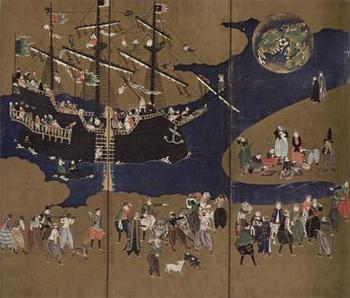Subproject 2: Visual Commerce in the Seaport: Nanban Byōbu as Media of Mercantile Cultural Contact in Japan, 1590–1650
Nachfolger des Kanō Naizen (1570-1616), Ankunft eines portugiesischen Handelsschiffes, Ausschnitt aus einem sechsteiligen Faltschirm (byōbu), 156 x 330 cm, Tōshōdai-ji, Nara.
(Nora Usanov-Geissler)
This subproject will study the emergence of a visual topos of long-distance maritime trade in Japanese genre painting of the sixteenth and seventeenth centuries. By analogy to the perspective of the issues pursued in the field of »Portus and Emporium«, while modifying the specifics of the context, three guiding considerations will be the focus here:
1. The Topos of the Portus and Interpicturality
In accordance with the analytical category of the portus that is relevant to our project, conveying a symbolic view of (ex)territorial transfer processes, in this first step we will develop criteria for defining the nanban byōbu as an interpictorial medium in which visual cultures with different regional and temporal ranges are combined.
2. Kaimin and Nanbanjin: Images of Native and Foreign Cultures in Littoral Regions
Japanese historiography since the 1980s has addressed a historically far-ranging marginalization of maritime and littoral population (kaimin). With reference to this issue, the second step of the study will test an interpretive approach that analyzes the numerous mercantile practices depicted on nanban as the representation of maritime- and mercantile-oriented professional groups.
3. Byōbu – Biombo – Screens: The Mobile Multipanel Painting in a Transcultural Perspective
The final step of the study will develop approaches to a history of the transfer and transformation of the multipanel partition screen as a support capable of transcultural connectivity.


